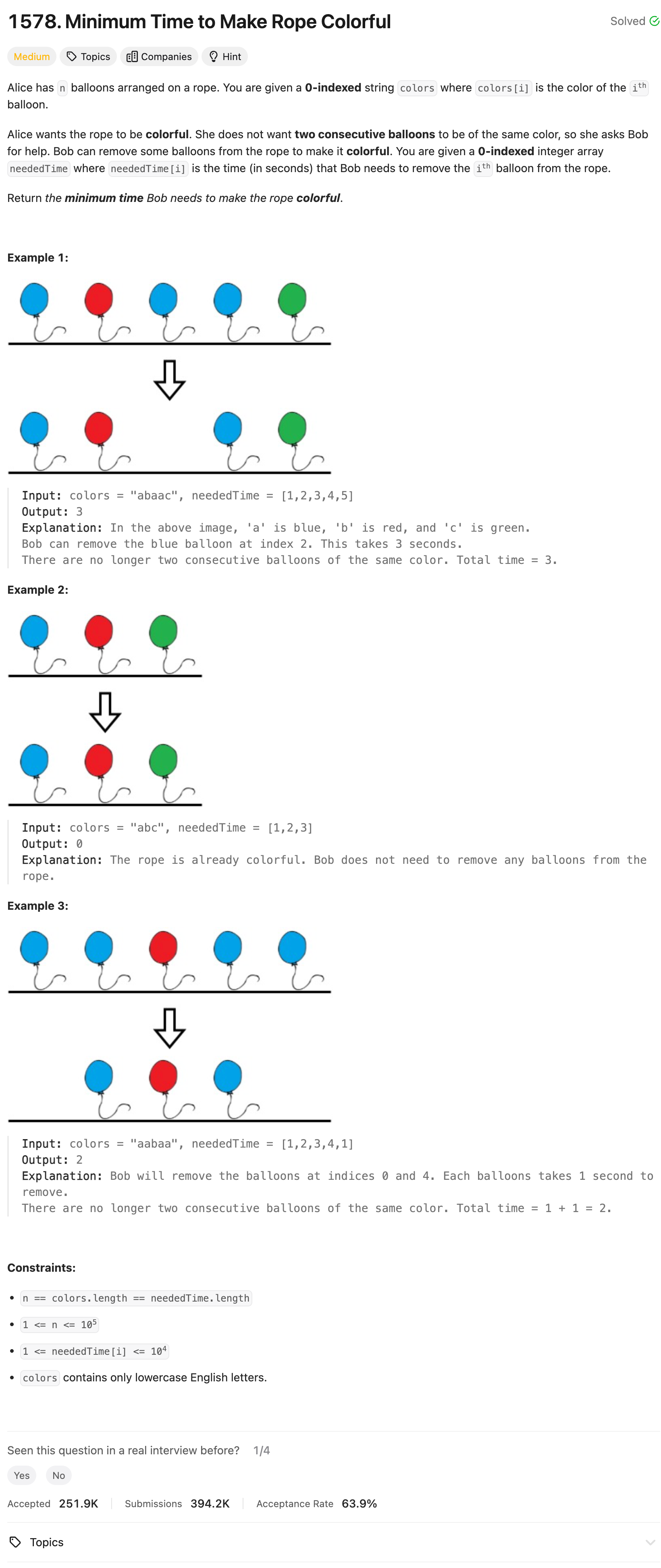Problem of The Day: Minimum Time to Make Rope Colorful
Problem Statement
Intuition
My initial thought was to utilize the two pointers approach to identify contiguous sequences of duplicated colors. By doing so, I could efficiently iterate through the list of colors and identify consecutive segments where the colors are the same.
Approach
To implement the approach, I utilized two pointers, start and end, to traverse the colors string. The start pointer indicates the beginning of a contiguous sequence of duplicated colors, while the end pointer moves forward to identify the end of this sequence.
Within each iteration, I checked if the colors at start and end are different. If they are the same, it implies that the sequence continues. I then accumulated the time needed to remove these duplicate colors, keeping track of the maximum time within this sequence. Once the contiguous sequence ends, I deducted the maximum time from the total time required.
After processing one contiguous sequence, I updated the start and end pointers to move to the next potential sequence.
Complexity
-
Time complexity: O(n)
-
Space complexity: O(1)
Code
class Solution:
def minCost(self, colors: str, neededTime: List[int]) -> int:
res = 0
N = len(colors)
if N == 1:
return res
start, end = 0, 1
while end < N:
if colors[start] != colors[end]:
start += 1
end += 1
else:
max_time = neededTime[start]
res += max_time
while end < N and colors[end] == colors[start]:
res += neededTime[end]
max_time = max(neededTime[end], max_time)
end += 1
res -= max_time
start = end
end += 1
return res
Editorial Solution
Approach 1: Two pointers
class Solution:
def minCost(self, colors: str, neededTime: List[int]) -> int:
# Initalize two pointers i, j.
total_time = 0
i, j = 0, 0
while i < len(neededTime) and j < len(neededTime):
curr_total = 0
curr_max = 0
# Find all the balloons having the same color as the
# balloon indexed at i, record the total removal time
# and the maximum removal time.
while j < len(neededTime) and colors[i] == colors[j]:
curr_total += neededTime[j]
curr_max = max(curr_max, neededTime[j])
j += 1
# Once we reach the end of the current group, add the cost of
# this group to total_time, and reset two pointers.
total_time += curr_total - curr_max
i = j
return total_time
Approach 2: Advanced 1-Pass
class Solution:
def minCost(self, colors: str, neededTime: List[int]) -> int:
# totalTime: total time needed to make rope colorful;
# currMaxTime: maximum time of a balloon needed in this group.
total_time = 0
curr_max_time = 0
# For each balloon in the array:
for i in range(len(colors)):
# If this balloon is the first balloon of a new group
# set the curr_max_time as 0.
if i > 0 and colors[i] != colors[i - 1]:
curr_max_time = 0
# Increment total_time by the smaller one.
# Update curr_max_time as the larger one.
total_time += min(curr_max_time, neededTime[i])
curr_max_time = max(curr_max_time, neededTime[i])
# Return total_time as the minimum removal time.
return total_time
